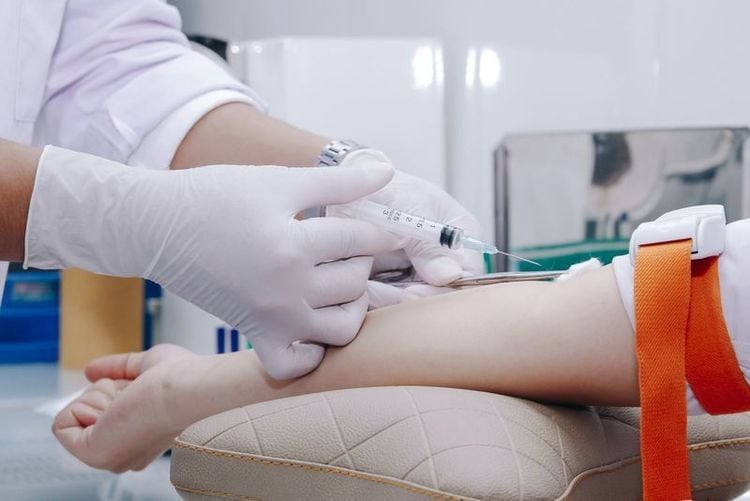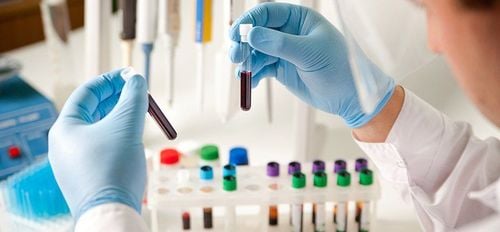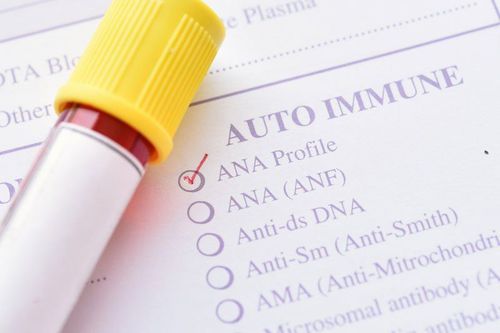This is an automatically translated article.
Antinuclear antibody (ANA) is an antibody against the nucleus of cells. Antinuclear antibody testing combines with clinical symptoms, a physical exam, and other tests to help your doctor find an autoimmune disease, including a diagnosis of lupus erythematosus.
1. Overview
Antibodies are proteins made by the body's immune system that help detect and fight infections. Antibodies usually target harmful substances, such as bacteria and viruses, and then trigger the immune system to attack to remove them from the body.Sometimes antibodies mistakenly attack healthy cells and tissues - this is called an autoimmune reaction. When antibodies mistakenly attack healthy proteins in the nucleus - the control center of cells, it is called an antinuclear antibody ANA.
If the body receives a signal to attack itself, it gives rise to autoimmune diseases such as lupus, scleroderma, mixed connective tissue disease, autoimmune hepatitis and other conditions. Symptoms vary by disease, and often include rash, swelling, arthritis, or fatigue. Of these, the most common is systemic lupus erythematosus, an autoimmune disorder that can affect various parts of the body, including the heart, lungs, kidneys, joints, skin, blood vessels, and Brain.
If there is only some ANA in the body there is no need to worry, but too much of this protein is a sign of an active autoimmune disease. A table of criteria will help determine the level of ANA in the blood. If levels are high (ratio 1:640 or higher), you may have an autoimmune disorder. However, conditions such as infections, cancer, and other medical problems can also lead to a positive ANA antinuclear antibody test result.

Bệnh Lupus xuất hiện có thể do cơ thể nhận được tín hiệu tự tấn công chính mình
2. Designation
Antinuclear antibodies to ANA are present in most people with active lupus. Doctors often use the ANA test as a screening tool. Looking at patterns of antibodies also helps identify the specific disease a person has, so a doctor can prescribe the most appropriate treatment.
Your doctor may order an ANA test if you have symptoms of lupus or other autoimmune disorders, such as:
Fever; a red, patchy or blood vessel-like rash (a symptom of lupus); Tired; Joint pain and swelling; Muscle pain. Many autoimmune diseases like lupus have similar signs and symptoms. Although the ANA test cannot confirm a specific diagnosis, it can be used to rule out certain conditions. If the ANA test is positive, the person will continue to have their blood tested for the presence of more specific antinuclear antibodies, some of which will be specific to the given disease.

Bạn có thể được chỉ định xét nghiệm ANA nếu có triệu chứng đau khớp
3. Prepare and proceed
To perform the antinuclear antibody test, the doctor needs to take a blood sample from the patient. If the blood sample is only used for this test, you can eat and drink normally before the test. In the event that the blood sample is being used for other additional tests, you may need to fast for a while before having the test as directed by your doctor.
Some drugs, such as epilepsy and heart drugs, will affect the accuracy of test results. So bring your doctor with a list of all the medications you're taking, even over-the-counter drugs or supplements.
For the ANA antinuclear antibody test, a nurse or nurse practitioner will draw a blood sample by inserting a needle into a vein in your arm. The blood sample is sent to a laboratory for analysis. You can return to your daily activities immediately after the test.
There is very little chance of a risk when a blood sample is taken from a vein. You may experience minor bruising or mild stinging at the site where the blood was drawn. In some cases, a vein can become swollen after a blood sample is taken, which is called phlebitis. Applying warm compresses several times a day will help with this problem.

Lấy máu được thực hiện trong quá trình xét nghiệm ANA
4. Test results
The presence of antinuclear antibodies will give a positive result, otherwise a negative result means no ANA was found. About 95% of people with lupus will test positive for antinuclear antibodies.
However, this result does not confirm that you have the disease. Many healthy people still have a positive ANA test result, especially women over the age of 65. This is called a false-positive test result. ANA titers may also increase with age in healthy subjects.
In addition to autoimmune disorders, a number of infectious diseases, drugs, and cancers have also been implicated in the development of antinuclear antibodies. Therefore, the results need to be analyzed by a doctor and combined with other additional tests to reach a conclusion.
If your doctor suspects you have an autoimmune disease, you will most likely be asked to do some more tests. ANA test results are a piece of information that helps doctors determine the cause of your signs and symptoms.

Sự hiện diện của kháng thể kháng nhân sẽ cho kết quả dương tính
5. Limitations of the test
Although most people with lupus have antibodies, a positive result does not necessarily indicate lupus. Positive results are also common with other diseases and a small percentage of people without lupus or any autoimmune disorder. Some people with autoimmune diseases may test negative for ANA, but positive for other antibodies.
Therefore, the ANA test alone is not sufficient to diagnose lupus erythematosus. Doctors must consider the results of this test in conjunction with many other criteria to diagnose lupus, such as:
Double-stranded DNA resistance; Anti-phospholipids antibodies; Anti-histones. In conclusion, the ANA test is particularly useful in diagnosing lupus erythematosus because more than 95% of patients will have a positive result. However, not everyone who tests positive has lupus, and conversely, not all lupus patients test positive. Therefore, the antinuclear antibody test cannot be used as a sole diagnostic method. Your doctor will decide on additional tests to do to determine the cause of the increased ANA in your blood.
Therefore, as soon as you have symptoms of autoimmune disease or signs of lupus, you should see a specialist as soon as possible for advice and treatment. To register for examination and treatment at Vinmec International General Hospital, you can contact Vinmec Health System nationwide, or register online HERE
References: medlineplus.gov, webmd. com, .mayoclinic.org, .healthline.com













